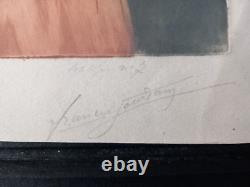
- Homepage
- Authenticity
- Characteristics
- Height
- Type
- Aquarelle (34)
- Dessin (135)
- Drawing (96)
- Eau Forte (16)
- Engraving (41)
- Figurine, Statue (97)
- Gouache (37)
- Gravure (262)
- Huile (189)
- Lampe De Table (35)
- Lithograph (16)
- Lithographie (44)
- Montre Bracelet (70)
- Oil (43)
- Pendule à Poser (17)
- Sanguine (34)
- Sculpture (654)
- Statue Sculpture (63)
- Statue, Sculpture (246)
- Watercolor (15)
- Other (1494)
- Weight
- Width
Francis Jourdain (1876-1958), Woman from the back, circa 1900, color aquatint







And died in the same city. He is recognized as one of the pioneers of the Modern Movement. By initiating the functionalist doctrine. Very ideologically committed to anarchism. His artistic approaches are diverse: painter.
For Pierre Kjelberg he is. "one of the most cutting-edge decorators of the interwar period. Surprisingly ahead of his time. He founded modern decorative arts. And theorized their application to popular living spaces by disseminating, from 1913, furniture.
Useful, streamlined, without ornamentation, designed to be mass-produced at low cost. Son of the architect Frantz Jourdain. Francis Jourdain benefits from numerous relationships in artistic circles with which he will engage.
From 1891 to 1899, he joined the group "Les Six," which brought together Alexandre Charpentier. Henri Nocq, Félix Aubert, and Tony Selmersheim who wanted to set the tone for a new decoration by strictly following the "truth of materials," making proportion, contrast, and material the only ornaments. It is about aligning the social ideal of William Morris. And the rationalism of Viollet-le-Duc. While abandoning their medieval ideals to achieve the simplicity of a "useful art" already claimed by Joseph Proudhon.The Group of Six thus announces the architecture of Auguste Perret. Already planning, for the 1900 Exhibition, a "modern foyer" that was to use the most recent techniques with a concrete structure, in an extremely rational construction and decoration.
But the only major achievement of this group remains the decoration of the Majorelle villa. In which Francis Jourdain participates and which fits fully into the Art Nouveau style. Pending further changes, the British magazine The Studio. Cites Alexandre Charpentier as the typical example of the "artisan-artist" sought by William Morris. And who is neither a bohemian.
Nor a sophisticated artist but a man of the people, an intelligent worker. It is in this direction that Francis Jourdain extends his commitment.
He supports the novelists of the common people, Charles-Louis Philippe. A friendship founded in the "fraternal group" where he is directly involved with his wife Agathe, around Charles-Louis Philippe, his current companion Milie, Léon-Paul Fargue. Charles Chanvin, Jules Iehl alias Michel Yell, Marguerite Audoux.
All will form the "Carnetin Group." - name of the village where they collectively rent a country house from 1904 to 1907. Alexandre Charpentier and Octave Mirbeau also animate the magazine L'Art pour tous, closely linked to the Popular University. Where the editors praise the ideas of William Morris without discrediting the machine, admitting that mechanization.
Is not inevitably a generator of frustration and ugliness. New ideas that will significantly influence Francis Jourdain. He collaborates with the anarchist magazines La Révolte. He takes a stand in favor of Captain Dreyfus. In 1904, he participates in the antimilitarist Congress in Amsterdam.
During which the International Antimilitarist Association was created. In 1912, along with a group of former anarchists from the newspaper La Guerre sociale. He joins the SFIO Socialist Party.
His father's relationships with artistic circles also allow Francis Jourdain to meet very important figures in the intellectual life of the time, thus meeting Claude Monet. And above all, becoming sensitive to painting. He also owes them his connection with his first master, Eugène Carrière.
From which he retains the idea that looking is also understanding. The principle of intelligibility of works that already brings him closer to the "honesty" of the Arts and Crafts.
Who painted his portrait in 1892. In 1893, he meets Vuillard and becomes friends with Henri de Toulouse-Lautrec. Who will introduce him to anarchist circles. Imbued with the fashionable idea of. His social sensitivity mainly distances him from the usual motifs, to capture moments of everyday life, entering scenes located in the suburbs and working-class neighborhoods. He does not simply reproduce a sketch but reinterprets by playing on the effects of memory, reflection, harmonization of volumes and colors. However, although he exhibits regularly and makes multiple attempts to establish himself between 1906 and 1912 in art salons and galleries, he is dissatisfied and will prefer to specialize in furniture. Francis Jourdain's shift towards furniture can be easily explained by his political commitment, which convinces him to use the power of art to reform the intimate setting of daily life. These ideas are only expressed at the second Autumn Salon in 1904, in a buffet that he co-edited with Édouard Cousin and which inaugurates the series of "Interchangeable Furniture".These pieces of furniture should be simple, adaptable to multiple functions, inexpensive, and space-saving. He designs them in 1912 and starts producing them in series from the following year at his own company: "Les Ateliers modernes." He then definitively abandons painting and engraving. This transition to interior architecture also impacts his publications. The articles he writes for the magazine Les Cahiers d'Aujourd'hui focus on this subject in an anarchist editorial line that accuses French traditionalism in decoration and architecture.
In 1913, he has the first translation of Adolf Loos's "Crime and Ornaments" published in this magazine. The influence is broad and immediate on the Dadaists. As for Francis Jourdain, from that date on, he gives his furniture an extremely sober and rectilinear look - including those he installs in his new apartment in the building on rue Vavin.Which he then presents at the 1913 Autumn Salon. The reception of his work and its mixed success mark the beginning of a very long series of accusations that critics will level against the Modern Movement. "I was reproached for being severe, Jansenist.
German, soapbox collector, packer, coffin maker." He receives congratulations from Charles-Édouard Jeanneret. And an illustrated article on the front page of Jean Jaurès's newspaper. Although the whole is still far too expensive for a working-class family.However, his minimalism earns him recognition from Jacques Copeau. And he is entrusted - still in 1913 - with the design of the first sets for the Vieux-Colombier theater. Which inaugurates a new type of stripped-down and machinery-free staging.
As noted by Suzanne Tise. "The sets that Jourdain created for the theater between 1911 and 1913 were in line with his concept of domestic decoration: achieving a maximum with a minimum of means. More importantly, they expressed an ideal that was to permeate his entire work: letting the artist fade away rather than imposing an individual artistic style." This idea of utilitarian and non-decorative furnishing continues to inspire him in his future creations, such as the travel furniture for the Innovation brand (1918) or the nursery for. He expands his activities further when the Autumn Salon.Opens a section devoted to urban art: Francis Jourdain participates in 1923, proposing a potter's shop window. It is then that he gets closer to the architects Georges Djo-Bourgeois. They now stand out from other decorative artists. By emphasizing structure over decorative effects of colors and ornaments, they gain the favor of Robert Mallet-Stevens. Who selects them for the decoration of the villa Noailles.
In 1924, where he is featured with a chair in Marie-Laure de Noailles's room. A series armchair, circa 1930. The rift between the architects of the Autumn Salon.And those of the Society of Decorative Artists. Grows during the organization of the International Exposition of Modern Decorative and Industrial Arts. In 1925, even though Francis Jourdain and his friends temporarily remain in the Society of Decorative Artists camp. By working on the "French Embassy" pavilion rather than engaging in Le Corbusier's "New Spirit" pavilion. However, in 1929, the break becomes effective with the creation of the Union of Modern Artists.
(UAM) chaired by Robert Mallet-Stevens. With Francis Jourdain on the board of directors. This commitment also takes on a political dimension as the most radical members of the UAM also join the Communist Party. And are affiliated - like Francis Jourdain or Charlotte Perriand.
To the Association of Revolutionary Writers and Artists. (AEAR) in 1932 alongside André Gide. This period remains paradoxical because, despite the arrival of the Great Depression in France.The social modernism advocated by Francis Jourdain, Charlotte Perriand, or René Gabriel. From 1925 to 1930, he works mainly in luxury: for Princess Murat. And the private mansions built by Mallet-Stevens, including those of the brothers Jean and Joël Martel. Where in 1928 he creates sliding furniture that can be moved on two parallel rods fixed to the wall and where Charlotte Perriand also intervenes.
However, allows him to return to a more economical production with a minimalist piece equipped with interchangeable and re-combinable furniture entitled "Essay on decluttering for a young intellectual worker. Meeting for the liberation of prisoners and political detainees from Madagascar, Morocco, Tunisia, Algeria, and Black Africa, in the presence of Francis Jourdain. In 1939, Francis Jourdain definitively ceases his activities as a decorator, especially since he will be pursued by the Gestapo. Having gone into hiding in 1941, he joins the National Front for the Struggle for Freedom and Independence of France. He joins the French Communist Party.
After the Liberation of France. Implement on a large scale his ideas on housing layout and low-cost furniture, Francis Jourdain seems to have given up the game and only publishes a few texts to support this movement linked to Reconstruction. He does not hesitate to republish the photographs of his first ensemble created in 1913, thus reaffirming his ahead of his time, over 30 years. Grave of Francis Jourdain, Paris. He now dedicates most of his time to art criticism and the history of the artists he met in his youth such as Toulouse-Lautrec. And to writing his memoirs. He is a member of the board of directors of the magazine La Pensée founded by Paul Langevin. Co-founder of the French Popular Relief. He serves as its president from 1948 until his death in 1958. He is buried in the Montparnasse Cemetery.
